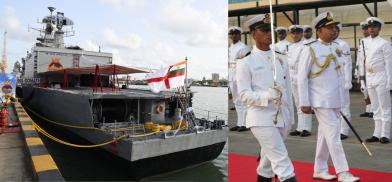A touching farewell to a battle-hardened warship
Battleships decommissioned in the future should also be developed as museums to attract general public -- on ground and on water too

On May 28, at sunset, the naval ensign atop the INS Gomati was hauled down for the last time. Its many previous commanding officers lined up on the helo (helicopter) deck. A huge audience of Indian Navy persons, veterans and other citizens in the pavilions on the wharf saluted the ship and the ensign one last time, bidding the iconic ship goodbye.
As the bugler played the Last Post, the Paying Off Pennant was gently hauled down. The Paying Off Pennant is an extremely long pennant, often with a float at its tip, flown in place of the commissioning pennant, by a ship returning to its home port to discharge its crew.
After a brief ceremony characterized by typical naval precision and elan, in a somber and poignant atmosphere, the simple report by Captain of the Ship, Capt Sudip Malik, to the Chief Guest, FOC in C West, Vice Admiral A.B. Singh, the “INS Gomati Decommissioned Sir” signalled the culmination of its 34 years of glorious service of this warship to the nation.
INS Gomati
The third ship of the Godavari class guided-missile frigates, INS Gomati was also the oldest warrior of the Western Fleet when decommissioned. During her service, she participated in Operations Cactus, Parakram and Rainbow, and several bilateral and multinational naval exercises. For her remarkable spirit and stellar contribution to national maritime security, she was twice awarded the coveted Unit Citation: in 2007-08 and 2019-20.
Any decommissioning, especially that of a Capital Ship (large battleship), brings in a flood of memories. Navy men and women believe that ships have souls; they not only bequeath great memories but leave behind 'footprints on the sands of time'.
The decommissioning of Gomati also signalled the completion of journey of the Godavari class, a grand project that the Indian Navy had taken up decades ago.
Gomati Gazette!
In those days, when the Internet, Google and smartphones were not around, ships had their own newspapers. Based on the previous night’s news broadcasts, revived on radio receivers, a designated officer (usually the Ship's ‘Doc’ - Medical Officer) would work his midnight hours to produce a few pages of printed publication.
With local ship gossip, jokes, anecdotes, pics and 'galley packets' included, the papers would acquire a nautical and unique individual touch. The Ganga newspaper was called 'The Ganga Times' and the Gomati newspaper was 'Gomati Gazette' or 'Gomgaz' for short.
Commodore Srikant Kesnur (Retd), interacting with this writer, referred to his article titled 'The G Force in the Indian Navy's River Sutra' of August 2010 and said: “When, we talk of the Godavari class, we must, above all, remember one man who made it possible - the legendary Capt Mohan Ram, the Chief Designer and the Principal Architect of this project and a true navy icon.
“For me personally and many of our vintage, the G class were our contemporaries. They were inducted in the mid-1980s, when we began our naval career and they were decommissioned over the last five years, as many of us retired or approached retirement. I never served on INS Gomati, though I sailed on her few times as Fleet Staff and for some Equipment Trials. But as an officer posted on INS Ganga, the sister ship, one always had the sibling love and rivalry that characterizes Navy ships. We were often berthed together, we spent time together in sea and harbour. We collaborated and competed with each other. The Gomati crew were our ‘Frenemies’, great professionals and good friends.”
G class goes
The end of the G class era leaves an emotional void for many naval veterans. And yet, in a Navy that is growing in leaps and bounds, there is the fond expectation that they will be reborn soon in new, more powerful embodiments. Just as this lot of G class were not only indigenous but hugely superior to the earlier generation of the Gs, so will be the succeeding ones.
So far, India has not had a policy of using decommissioned warships as floating museums. When INS Vikrant was decommissioned, it was sent out for getting cut. While in the US in 2014, this writer visited the aircraft carrier USS Intrepid, located in midtown Manhattan, on the Hudson River, which is a fascinating and educative sea, air and space museum, much visited by both adults and children.
Finally, India has decided now, after INS Gomati’s decommissioning, that the ship's legacy will be kept alive in an open-air museum being set up on the picturesque banks of the river Gomti in Lucknow, where several of her combat systems will be displayed as military and war relics.
Battleships decommissioned in the future should also be developed as museums to attract the general public -- on ground and on water too. They will be great catalysts for education with entertainment and will help enhance the inculcation of national pride among the Indian public, something we can well do with good doses of.
(The author is a former spokesperson, Defence Ministry and Indian Army. He can be contacted at wordsword02@gmail.com)
most useful websites on the internet. I'm going to
highly recommend this website!









Post a Comment